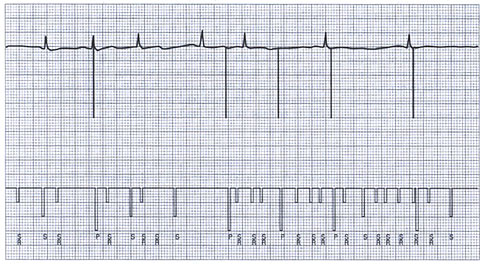
Figure 16 v
Electrocardiogram and marker channels are shown for a patient with a ventricular lead impedance break. Note that based on the ECG there is failure to sense, as manifested by the second and fourth pacing outputs coming very shortly after the QRS complex. There is failure to capture, demonstrated by the second and third pacing outputs, which should capture the ventricle. There is also evidence of oversensing, as demonstrated by the long pause between the fourth and fifth pacing outputs during a diastolic period that exceeds the interval between the previous two pacing outputs. In general, when there is evidence of oversensing, underserising, and failure to capture, then the likely etiology is either a lead insulation break, lead fracture, or other mechanical problem. The marker channels confirm the above ECG findings. There are sensed ventricular events (S or SR) that do not correspond to surface QRS complexes, consistent with oversensing. Additionally, the erratic pattern of sensed ventricular events is consistent with electrical noise. There are also lack-of-sense markers corresponding to QRS complexes; finally, there are ventricular pace markers (P) that fail to capture the ventricle.
Mitrani,R.D. and others,Cardiac Pacemakers,Hurst's The Heart,10th edition,Vol.1,pp.963-992